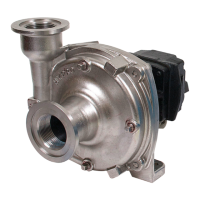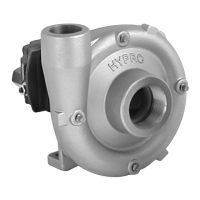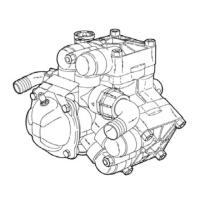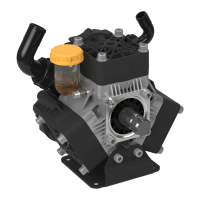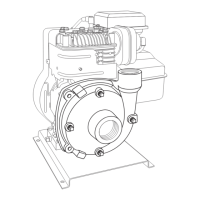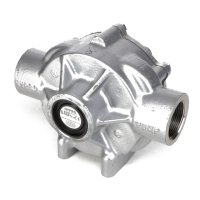-7-
Closed Center (Pressure-Compensated) —
HM2C and HM4C Models Only
On a pressure-compensated system, the amount of oil that
is allowed to flow through the hydraulic motor is regulated
by a metering orifice in the pressure port adapter. Three
different sizes of orifices are supplied with the HM2C and
HM4C model pumps to allow flexibility in the flow required for
individual sprayer needs.
The smaller the orifice, the less hydraulic oil goes through
the motor, so the pump will run slower and the flow of liquid
pumped and the spray pressure will also be less. As the
hydraulic oil flow is increased (by installing a larger orifice),
the amount of liquid being pumped and the spray pressure is
also increased.
Installing and Removing Metering Orifice
1. Shut off the hydraulic system.
2. Disconnect the line to the pressure port of the hydraulic
motor.
3. Remove the adapter from the motor using a 1-1/16’’
wrench. Make sure the o-ring is on the metering orifice
before installing into port adapter.
4. The orifice is removed or installed in the port adapter by
tapping either in or out of the adapter.
A. To remove — tap the orifice out from the small end
of the adapter.
B. To install — tap the orifice in from the large end of
the adapter. The orifice is seated when a snap sound
is heard.
Adjusting Centrifugal Pump Output
1. Open the bypass adjusting screw in the hydraulic motor
three (3) turns.
2. Start the tractor and allow the hydraulic oil to circulate
for approximately 10 to 15 minutes or until adequately
warmed.
3. Close and lock down the bypass adjusting screw in the
hydraulic motor.
4. Prime the centrifugal pump with all valves open (See
Installation Instructions and System Configuration
Diagram).
5. Close the agitation line valve and the control valve; open
the boom shut-off valve.
6. With the pump running, open the control valve until the
pressure gauge indicates the desired spraying pressure.
7. Open the agitation line valve until sufficient agitation is
observed. Then, if spray pressure drops, readjust the
control valve to restore to the desired pressure.
8. If a sufficient boom pressure cannot be attained, install
the #2 size orifice and repeat Steps 5 through 7.
9. If a sufficient boom pressure still cannot be attained with
the #2 size orifice, install the #3 size orifice and repeat
Steps 5 through 7.
10. If a sufficient boom pressure still cannot be attained
with the #3 size orifice, remove the orifice and repeat
Steps 5 through 7.
Closed Center (Load Sensing) — All Models
Many tractors are being introduced with load sensing
systems (also referred to as flow and pressure- compensated
systems) which simplify system setup and eliminate many
of the problems associated with using the wrong size pump
motors on a given hydraulic system. Usually, any of Hypro’s
9300HMC models may be used on this type of system,
provided the hydraulic system produces sufficient oil flow for
the hydraulic motor being used (Refer to the Pump Selection
Guide).
This system maintains a constant flow of hydraulic oil for a
given pressure drop. The flow is adjustable with a flow control
valve installed in the hydraulic system (such as the Tortoise/
Hare control on John Deere tractors). Because this system
has adjustable flow, there is no need to bypass hydraulic oil
as in an open center system, or to restrict the flow with orifices
as in a closed center pressure- compensated system.
Adjusting Centrifugal Pump Output
1. Make sure the orifice from the pressure port adapter
of the hydraulic motor has been removed (HM2C and
HM4C models only).
2. Close and lock down the bypass adjusting screw in the
hydraulic motor.
3. Set the tractor hydraulic flow control valve for minimum
hydraulic oil flow to the remote outlet (Tortoise position).
4. Start the tractor and allow the hydraulic oil to circulate
for approximately 10 to 15 minutes or until adequately
warmed.
5. Prime the centrifugal pump with all valves open (See
the Installation Instructions and System Configuration
Diagram).
6. Close the agitation line valve and open the control valve
and the boom shut-off valve.
7. Slowly adjust the tractor hydraulic flow control valve until
the desired boom pressure is attained.
8. Open the agitation line valve until sufficient agitation is
observed. If spray pressure drops, readjust the tractor
hydraulic flow control valve to restore it to the desired
pressure.
Flush Pump After Use
One of the most common causes for faulty pump performance
is gumming or corrosion inside the pump. Flush the pump
and entire system with a solution that will chemically
neutralize the liquid pumped. Mix this solution according to
the manufacturer’s directions. This will dissolve most residue
remaining in the pump, leaving the inside of the pump clean
for the next use.
To Prevent Corrosion
After cleaning the pump as directed above, flush it with a
permanent-type automobile antifreeze (Prestone®, Zerex®,
etc.) containing a rust inhibitor. Use a 50% solution, half
antifreeze and half water. A protective coating will remain on
the inner pump surfaces. Save the excess antifreeze for the
next application. Plug the ports to keep out air during storage.
For short periods of idleness, noncorrosive liquids may be left
in the pump, but air must be kept out. Plug the ports or the
seal port connections.
L-1526 (12/12, Rev. B)

